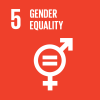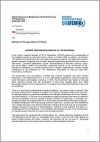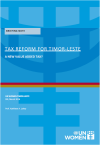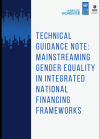FOUND 10 RESULTS
The Government of Andalusia has presented, as part of its 2018 Budget Bill, its Gender Impact Assessment Report. The report is an ex ante evaluation of the resources that the Government of Andalusia allocates to the promotion of gender equality. The Report, together with G + Program and Gender Budgeting Audits, are the main elements of the Gender Budgeting strategy in the Andalusian region.
Since the start the COVID-19 pandemic, almost USD 16 trillion has been pumped into the global economy, and governments are now rolling out second and third phases of support. With the introduction of vaccines, some countries can begin to get the pandemic under control and start investing in recovery. Most countries, however, are still grappling with the pandemic’s immediate health and socio-economic fallout, including its outsized impact on women. While the adoption of policy measures to prevent or respond to the surge in violence against women is more widespread, the social protection and jobs response has not adequately supported women’s economic security nor addressed care work or the financing of care services. This policy brief presents entry points for the application of gender-responsive budgeting to COVID-19 support and recovery packages. Drawing on country examples, this brief provides recommendations on the use of gender budgeting tools to identify gaps in policy responses and direct spending towards gender responsive COVID-19 measures.
Sustainable Development Goal (SDG) Indicator 5.c.1 “Proportion of countries with systems to track and make public allocations for gender equality and women’s empowerment” has been recently reclassified as Tier II by the Inter-Agency Expert Group on SDGs. The indicator measures progress towards Target 5c of the SDGs to “adopt and strengthen sound policies and enforceable legislation for the promotion of gender equality and the empowerment of all women and girls at all levels”. It links the policy and legal requirements for gender equality with resource allocations for their implementation. By tracking resource allocations, governments introduce deliberate measures into the planning and budgeting cycle to meet their gender policy objectives such as eliminating gender based violence or increasing women’s employment. By making these allocations public, governments commit to higher levels of transparency and accountability in budget decision making.
Since the start of the COVID-19 pandemic, almost USD 16 trillion has been pumped into the global economy, and governments are now rolling out second and third phases of support. With the introduction of vaccines, some countries can begin to get the pandemic under control and start investing in recovery. Most countries, however, are still grappling with the pandemic’s immediate health and socio-economic fallout, including its outsized impact on women. While the adoption of policy measures...
Paper discussing the definition and measurement of Sustainable Development Goal (SDG) Indicator 5.c.1 (reclassified to Tier II) and discussing the relationship of SDG Indicator 5.c.1 with other Indicators.
This fact sheet was produced by UNIFEM in 2007 under the UNIFEM sub -regional programme "Gender-Responsive Budgeting in South East Europe: Advancing...
This paper provides guidance on how to make Public Finance Management (PFM) reforms gender responsive. It presents an overview of PFM reforms and explains how and why they are important to the achievement of gender equality outcomes. The paper aims to link ongoing work on gender responsive budgeting (GRB) with broader PFM reform efforts by increasing understanding of GRB among PFM practitioners and increasing understanding of PFM reforms among gender experts to support better results for gender equality and women's empowerment.
Governments raise tax revenues so that they can meet the needs of the people they represent. Fair and equal taxation makes sure that tax laws do not discriminate against people who live traditional lives, subsistence farmers, rural business owners, women, or the poor
Integrated national financing frameworks (INFFs) were first introduced in the Addis Ababa Action Agenda to support increased alignment of financing from all sources with national sustainable development objectives. The technical guidance aims to support countries to integrate gender equality objectives and gender analysis into the design and implementation of INFFs.
This book aims to contribute to the evolving understanding of public expenditure management as a political, rather than a purely technical, process. In particular, it explores the ways in which a rights approach can contribute to strengthening pro-poor voice and outcomes in budget processes. It identifies issues, partners, tools and methods that may help development actors to support citizen accountability and a pro-poor, gender-equitable, focus in public expenditure management.






